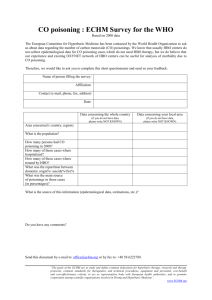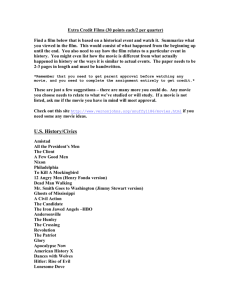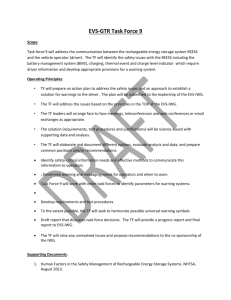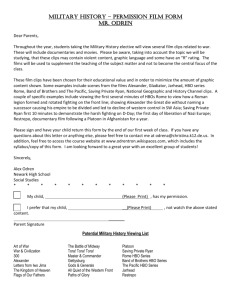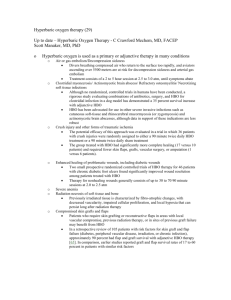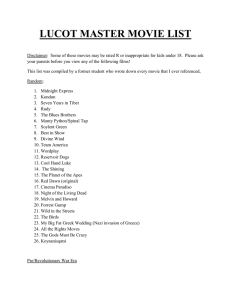Scientific Foundations Committee In Attendance Absent:
advertisement
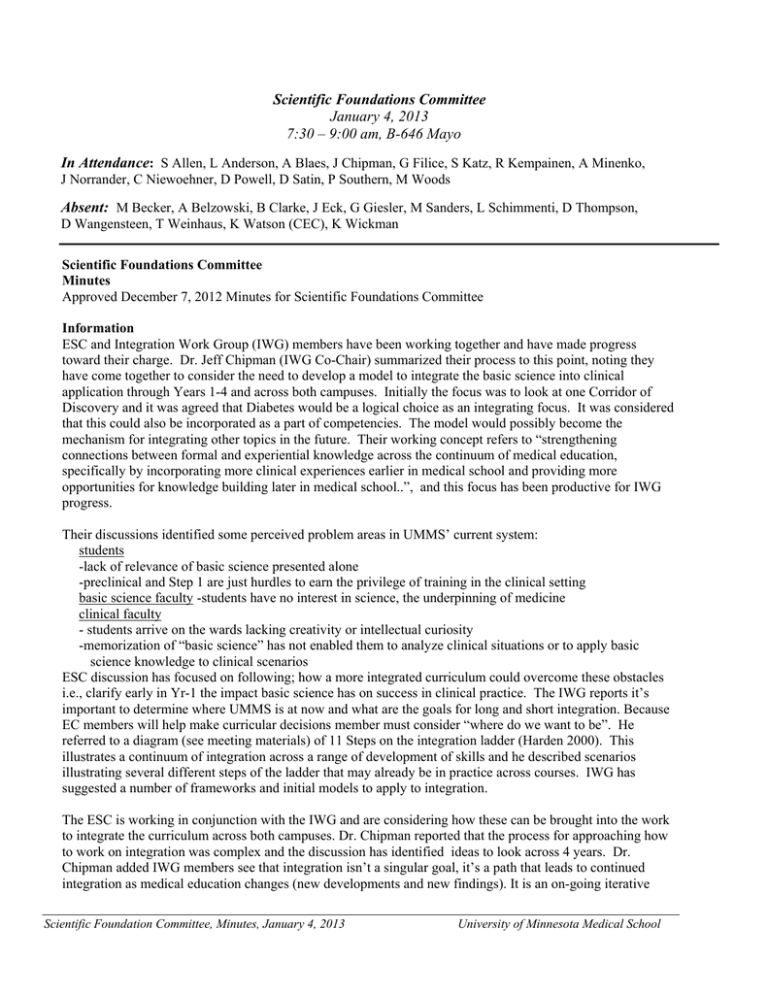
Scientific Foundations Committee January 4, 2013 7:30 – 9:00 am, B-646 Mayo In Attendance: S Allen, L Anderson, A Blaes, J Chipman, G Filice, S Katz, R Kempainen, A Minenko, J Norrander, C Niewoehner, D Powell, D Satin, P Southern, M Woods Absent: M Becker, A Belzowski, B Clarke, J Eck, G Giesler, M Sanders, L Schimmenti, D Thompson, D Wangensteen, T Weinhaus, K Watson (CEC), K Wickman Scientific Foundations Committee Minutes Approved December 7, 2012 Minutes for Scientific Foundations Committee Information ESC and Integration Work Group (IWG) members have been working together and have made progress toward their charge. Dr. Jeff Chipman (IWG Co-Chair) summarized their process to this point, noting they have come together to consider the need to develop a model to integrate the basic science into clinical application through Years 1-4 and across both campuses. Initially the focus was to look at one Corridor of Discovery and it was agreed that Diabetes would be a logical choice as an integrating focus. It was considered that this could also be incorporated as a part of competencies. The model would possibly become the mechanism for integrating other topics in the future. Their working concept refers to “strengthening connections between formal and experiential knowledge across the continuum of medical education, specifically by incorporating more clinical experiences earlier in medical school and providing more opportunities for knowledge building later in medical school..”, and this focus has been productive for IWG progress. Their discussions identified some perceived problem areas in UMMS’ current system: students -lack of relevance of basic science presented alone -preclinical and Step 1 are just hurdles to earn the privilege of training in the clinical setting basic science faculty -students have no interest in science, the underpinning of medicine clinical faculty - students arrive on the wards lacking creativity or intellectual curiosity -memorization of “basic science” has not enabled them to analyze clinical situations or to apply basic science knowledge to clinical scenarios ESC discussion has focused on following; how a more integrated curriculum could overcome these obstacles i.e., clarify early in Yr-1 the impact basic science has on success in clinical practice. The IWG reports it’s important to determine where UMMS is at now and what are the goals for long and short integration. Because EC members will help make curricular decisions member must consider “where do we want to be”. He referred to a diagram (see meeting materials) of 11 Steps on the integration ladder (Harden 2000). This illustrates a continuum of integration across a range of development of skills and he described scenarios illustrating several different steps of the ladder that may already be in practice across courses. IWG has suggested a number of frameworks and initial models to apply to integration. The ESC is working in conjunction with the IWG and are considering how these can be brought into the work to integrate the curriculum across both campuses. Dr. Chipman reported that the process for approaching how to work on integration was complex and the discussion has identified ideas to look across 4 years. Dr. Chipman added IWG members see that integration isn’t a singular goal, it’s a path that leads to continued integration as medical education changes (new developments and new findings). It is an on-going iterative Scientific Foundation Committee, Minutes, January 4, 2013 University of Minnesota Medical School process. Work is necessary to move beyond “awareness” to accomplish other levels of the ladder. Duluth has had the co-director model in place for several years. Dr.Rosenberg noted that integration of new knowledge to existing knowledge is a life-long skill that crosses the continuum of integration. Teaching medical students how to integrate new knowledge is an important skill they will use over years of clinical practice. ESC has talked about integration as a mechanism for the School in how to deploy and implement as a bi-campus process. Assessments and milestones are one approach to integration across campuses. Annual Course Report Dr. Kempainen provided and overview of HD-1 for Fall, 2012 Changes from last year Formative feedback in the form of a mid-term exam was added as an opportunity for students to understand where they were in terms of progress. The goal is to have rely less on recall and understand the need to understand application of knowledge. Pathology lab points were changed in how they are awarded As an approach for integration it seems to work better if the pathophysiology is taught before they begin to learn about (for example) cardiac dysrhythmia in the clinical sense On the flip side, integration means having to tell a physician lecturer that their lecture takes place at a very specific time and date (3 months in advance) is an indication of loosing flexibility. Held a pathophysiology review for cardio, added partway through the 6 week course. this year there is a required path lab combined attendance and participation Medical Educaiton staff Mark Hilliard, Caitlin Pine put the exam on-line in Black Bag which worked well. Dr. Kempainen reported that “evidence the objectives of the course are being achieved”, is evident for the final exam in that for the written exam the mean was 83% standard deviation and was definitely a bell curve. He feels positive about spreading the scores out a bit as a sign that it’s a challenging exam, 4 students didn’t pass the written exam. He doesn’t necessarily like to see students fail, but on the rate seems logical. His sense is that 1-2% failure on HD1 exam, means they are identifying the individuals who are at risk early on, so they will get help on areas where they have deficiencies. Dr. Katz, a member of COSSS has over the past 2 years, been involved in the review of each student who failed HD. He noted that with the exception of 1 or 2, those students were problematic and were correctly identified early as at risk, making it possible to individualize guidance for each in area of deficiency. For the Pathology cases, while working out answers to the different parts of the clinical scenarios students in small groups, have to work together to agree on which of the choices is correct and why the other 2 choices are not acceptable. It isn’t designed to be difficult because the individual scores are tied to how well the group does, which could affect students’ qualification for “honors” in HD1. They did well and seem to enjoy the unique challenges the format requires. Feedback from lab and small group leaders is informal and has been favorable, if students were not performing or not prepared he would receive that information from group leaders. This year’s class seems to be a group who work hard and are engaged in trying to work together to learn and are vocal when participating in small group activities. Dr. Chipman noted that limiting the score based on the group score, talked about “inter-professional education” and although this is an interactive experience it is clinically relevant. As such when they begin to work with other physicians on a patient and patient care where there may be conflicting diagnoses they will have this experience. Dr. Kempainen indicated the activity is designed to establish that type of exercise. Dr. Chipman suggested maybe there is value in making them work together and then grading them individually on how well the group performs together in a group evaluation. Each would a get an individual grade based upon the group performance. If they perform poorly and have a poor group dynamic, it reflects on the individual as a member of the group. It is part of the professionalism and communication. The groups are assigned not self-selected and are established to move student out of previous working partnerships. Scientific Foundation Committee, Minutes, January 4, 2013 School University of Minnesota Medical For the evaluation question on grading “do assessments appropriately test the course objectives”, went from 3.8 and 4.2, which reflects improvements made on the actual exam questions. Most importantly it confirms the evaluation question, “overall I acquired an understanding of the stated course objectives” (a summary question) for him the course it meeting the objectives and has improved in the student view at 4.4 on a 1-5 point scale. Students’ approval on “course integration and the clinical relevance of the objectives the course covered were clear”, provides insight into their understanding of why they were required to learn what was being taught in HD1. Only slightly more than 100 students completed the course evaluation, down from 150 in the previous year. Students were required to complete the evaluation to be considered for “honors” and Dr. Kempainen express a sense that this may add bias to the student responses. Other areas that can be considered favorable for students’ learning the course content are Board scores. He pointed out that learning the cardiovascular and respiratory systems includes much more learning of the basic science than just HD1. Also In spite of the difficulties in HD1 in its 1st year of offering, the students did well on their Step 1 Board Exam, but it isn’t easy to specifically gage their achievement in any one area of the Exam Areas going well include small groups which gets students excited about the topic and course content. Year after year student write comments about their appreciation for small group learning. He noted improvement in communication and integration for the logistics of material and course content across all of the disciplines; each year the faculty look at the order of the lecture content. They re-examine redundancy to determine what is good and remove those areas where it isn’t productive for students and also review consistency in what is taught across disciplines and faculty. Black Bag is much better than Moodle; three fourths of the lectures are rated at 4 or higher; and those giving a number of lectures are rated higher. Pathology Lab Practical there are 20 questions and if a student doesn’t pass the Path Lab, they fail all of HD1, they must achieve 70% of the 20 questions to pass. The faculty are meeting to try to decide what options they might want to consider. Dr. Powell noted a couple of students failed the summer lab course and in HD1 (yr2); which is concerning. Her question, “what is it about those students that means they can’t look at images and answer questions about the slides” is concerning because it is tested on the USMLE Step 1. Currently sequestered exam questions should be of the highest quality. Suggestion to establish across all of Year 1 and 2, a policy across all courses for a set percentage of students with correct answers to a question(s) and if that percentage isn’t achieved then the questions is eliminated. Medical Education office cannot assess the content or to figure out what is a valid and fair question. When 70 % is required separately on a course overall and on the exam, a philosophical point is whether you use a competency based approach or when awarding “honors” adopt the approach that there should be questions that are so difficult to answer that the author knows only a very a small portion of students will be able to provide the correct answer; and the School decides to fail students just to be able to use this type of exam question. The exams become more high stakes; the difference between honors and pass doesn’t have a great impact; the difference between pass and fail is enormous. Dr. Niewoehner indicated this is a larger discussion for future meetings. How to improve: -make sample questions in the mid-term more difficult -small group rooms are a problem across all of AHC ID feedback is relatively low; he feels it is difficult for students to put ID into the broader context of the 2nd year. Much of what is taught are the general principles and applying general principles to a large number of clinical scenarios; is a great deal different than the rest of the delivery of principles with more gradual exposure to the “how and where” it applies to clinical practice. Having it happen in HD1 is not especially the most opportune time for it to appear. Dr. Filice talked about the goals he has established for ID that students see ID in ways they will see it in their practice. His course requires students to use ILT to study the content Scientific Foundation Committee, Minutes, January 4, 2013 School University of Minnesota Medical before the materials is covered in class sessions. The course is case based and assigned readings are important to understanding the materials as it is organized for the course. Students who do both readings and study the cases will have a better opportunity to learn the principles and application, if the reading isn’t done consistently the students won’t understand the cases. He is considering changing the first two sessions to help students see where the content is leading to throughout the HD courses. Dr. Minenko noted that Dr. Filice’s expectation that students be prepared for class sessions by reading material and cases are the same expectations they find in other non-HD courses. Students begin to understand how that flows while in HD1 and it gains more strength in HD2 and forward. Changes planned: -change the format for how final exams are graded -increase the difficulty of the mid-term and practice questions, adding more questions for practice -attempt further integration on the congenital heart disease content and peripheral vascular content -more emphasis about setting their expectations that this is what they need to be covering before they get it in class -up front statement “not all material will be covered in class and the student is responsible to cover it” -use a summary page as a tool for learning Next SFC Meeting: February 1, 2013 Scientific Foundation Committee, Minutes, January 4, 2013 School University of Minnesota Medical

